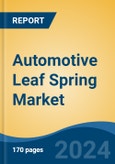Parabolic Type is the fastest growing segment, Asia-Pacific is the largest regional market
Speak directly to the analyst to clarify any post sales queries you may have.
10% Free customizationThis report comes with 10% free customization, enabling you to add data that meets your specific business needs.
Key Market Drivers
The global automotive leaf spring market is substantially influenced by expanding commercial vehicle production, directly increasing the need for robust suspension systems across diverse industrial sectors. Rising growth in logistics, construction, and agriculture worldwide intensifies demand for new heavy-duty trucks, buses, and light commercial vehicles.These predominantly utilize leaf springs due to their proven reliability in demanding operational environments. According to the International Organization of Motor Vehicle Manufacturers (OICA), global commercial vehicle production reached 26.8 million units in 2023, marking a 12% increase from the previous year, underscoring the significant expansion in this foundational automotive segment. This consistent manufacturing growth significantly drives original equipment manufacturer demand for leaf springs, especially in emerging economies undergoing rapid infrastructure development.
Key Market Challenges
The intensifying competition from alternative suspension technologies, particularly air and coil spring systems, presents a significant impediment to the growth of the Global Automotive Leaf Spring Market. These alternative systems typically offer enhanced ride comfort and advanced handling characteristics, which are increasingly prioritized by both manufacturers and consumers. This drives their adoption in vehicle segments where such attributes are crucial.Key Market Trends
The global automotive leaf spring market is increasingly adopting lightweight composite materials, driven by demands for enhanced fuel efficiency, reduced emissions, and improved vehicle performance, which is particularly critical for electric vehicle range. Made from fiber-reinforced polymers, composite leaf springs offer significant weight reduction over traditional steel, lowering unsprung mass and improving dynamic handling. The American Composites Manufacturers Association reported the global market for light vehicle composite materials reached approximately 4.4 billion pounds in 2023, reflecting increasing adoption beyond conventional materials.Key Market Players Profiled:
- Hendrickson
- Rassini
- Sogefi
- NHK Spring
- Jamna Auto
- LITEFLEX
- IFC Composite
- Owen Springs
- Frauenthal
- Mitsubishi Steel
Report Scope:
In this report, the Global Automotive Leaf Spring Market has been segmented into the following categories:By Vehicle Type:
- Passenger Cars
- Commercial Vehicles
By Type:
- Parabolic
- Elliptic
- Semi-Elliptic
- Others
By Material:
- Metal
- Composite
By Region:
- North America
- Europe
- Asia-Pacific
- South America
- Middle East & Africa
Competitive Landscape
Company Profiles: Detailed analysis of the major companies present in the Global Automotive Leaf Spring Market.Available Customizations:
With the given market data, the publisher offers customizations according to a company's specific needs. The following customization options are available for the report.Company Information
- Detailed analysis and profiling of additional market players (up to five).
This product will be delivered within 1-3 business days.
Table of Contents
Companies Mentioned
The companies profiled in this Automotive Leaf Spring market report include:- Hendrickson
- Rassini
- Sogefi
- NHK Spring
- Jamna Auto
- LITEFLEX
- IFC Composite
- Owen Springs
- Frauenthal
- Mitsubishi Steel
Table Information
| Report Attribute | Details |
|---|---|
| No. of Pages | 180 |
| Published | November 2025 |
| Forecast Period | 2024 - 2030 |
| Estimated Market Value ( USD | $ 4.95 Billion |
| Forecasted Market Value ( USD | $ 6.3 Billion |
| Compound Annual Growth Rate | 4.1% |
| Regions Covered | Global |
| No. of Companies Mentioned | 11 |









